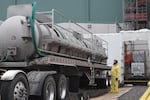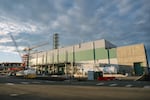A nearly two month long study is underway at the Hanford cleanup site, in southeast Washington state.
It’s looking at a new stack on the Waste Treatment Plant — and how to keep too many chemical emission nasties from coming out of it.
The new study is meant to test the off-gas systems and a range of chemical scrubbers.
This is all happening at the massive Waste Treatment Plant’s Low-Activity Waste Facility. When the chemicals are tested, there will be detailed calculations of what’s coming out of that stack.

Workers offload chemicals into the Low-Activity Waste Facility at Hanford Vit Plant. Nitrogen, mixed with other materials, will simulate Hanford tank waste and be used to prepare the facility for operating with radioactive and chemical waste, possibly later this year.
Courtesy of Bechtel
So far, no radioactive material is being treated in the plant. Suzanne Dahl, with the Washington state Department of Ecology, is one of the very top watchdogs over the project, working as the tank waste treatment section manager.
“We’ve seen years of permitting documents go back and forth,” Dahl said. “And design documents. We’ve had a field presence throughout the whole time. And then right now, they’re going through their cold commissioning stages.”
This more than 200-foot stack is attached to part of the hulking Waste Treatment Plant. The Hanford team is introducing ammonia and nitrous oxide-producing chemicals into the Waste Treatment Plant melters to replicate tank waste, ensuring systems are fully up and running.
The ultimate goal of this study: see if the chemical load being emitted matches Hanford officials’ expectations, and are under state limits.
“That’s very exciting,” Dahl said.
“We’re gonna be for the next 40-50 days out in the field everyday, doing environmental testing. And making sure that the main process there, is they take the simulant waste and they inject different chemicals in it and then they measure the chemical emissions at the stack, at the emission point, to make sure the off-gas systems are doing their job.
“And then you’ll know that anything that’s going out of the stack is going to be protective (of environmental and human health),” she added.
Brian Hartman is the project director for Bechtel, the main federal contractor responsible for the plant.
“We’ll take our feed system, where we operate the plant, and then we will actually go in and add what we call spiking chemicals to see ‘Hey, does our instrumentation measure what we spiked into the melter itself?’” Hartman said.
The test must be approved by the Washington State Department of Ecology before the plant can move on to hot commissioning. That’s when actual radioactive and chemical waste is treated — possibly later this year.
There’s a lot riding on the plant start up: A milestone agreement with the WSDOE, the Environmental Protection Agency and U.S. Department of Energy calls for deadlines for the plant to start up the Low-Activity Waste Facility on August 1, 2025.
But Hartman says that pressure isn’t going to drive the plant’s start up.
“It’s not the schedule for when we bring this plant online, it’s that we can go do it while we’re being safe and we’re going to be reliable to kind of protect the equipment, the people and sort of the process,” Hartman said. “So, we try not to focus in on a schedule date. We let the plant and the processes drive us to where we’re going to be.”
Hartman said this plant is decades in the making, and he doesn’t want to hurt the environment or anyone by starting it up before it’s ready.

Hanford workers monitor systems from control room stations at the Low-Activity Waste Facility at the Waste Treatment Plant at Hanford.
Courtesy of Bechtel
Radiological testing
The state Department of Health will lead oversight of radiological monitoring when the plant has radioactive waste material pumping through it — making sure that no radioactive waste escapes into the environment.
That will require additional testing, and continuous monitoring.
In an email response to questions, the state health department said: “We will implement monitoring for radioactive air emissions and also conduct environmental monitoring for radioactive materials.”
The department also wrote: “The Department of Health (DOH) Radioactive Air Emissions License will require the Department of Energy to conduct real time monitoring with alarm capability & continuous sampling for record of radioactive air emissions from the melter stack. Additionally, DOH will continue to co-sample at various monitoring stations, as part of its normal oversight of the Department of Energy (DOE) environmental monitoring program on the Hanford Site. This will include sampling of ambient air, soil, vegetation, and water. All results are reviewed by DOH.”
Related: It’s been 80 years since the world’s first industrial-scale nuclear reactor went live at Hanford
The history
Populations around Hanford are keen to have robust air emissions controls.
It was in 1949 when the Downwinders were exposed to Hanford’s infamous Green Run, and releases before and after that event from 1944 through 1972.
Still, others point out some of the past problems with the massive plant, and their continued hopes for cleanup this time.
“After decades of delays and an enormous price tag, it finally feels like we’re on the brink of vitrification at Hanford,” said Nikolas Peterson, the executive director of Hanford Challenge, a Seattle-based watchdog group.
“We can only hope that the hard-earned lessons from courageous whistleblowers have been fully embraced and that past issues have been resolved. Passing these rigorous environmental tests is essential to ensure the safety of both workers and the public before the facility begins handling radioactive tank waste.”

The Low-Activity Waste Facility, or LAW, looms large at Hanford. It’s a key part of a couple dozen buildings that make up the Waste Treatment Plant at the cleanup site in southeast Washington.
Courtesy of Bechtel
Start up details
Once full-scale operations start at the Waste Treatment Plant, the plant will process about 5,300 gallons of tank waste per day, according to a press release from the U.S. Department of Energy. It will mix the treated waste with glass-forming materials, heating it to 2,100 degrees Fahrenheit. Then, the materials will be poured into stainless steel containers for long-term storage.
“There’s still a lot of testing to go,” Hartman said. “There are a lot of moving parts that are all coming together, but everyone is working together really well.”
Anna King is a reporter with Northwest Public Broadcasting. This story comes to you from the Northwest News Network, a collaboration between public media organizations in Oregon and Washington.
It is part of OPB’s broader effort to ensure that everyone in our region has access to quality journalism that informs, entertains and enriches their lives. To learn more, visit our journalism partnerships page.